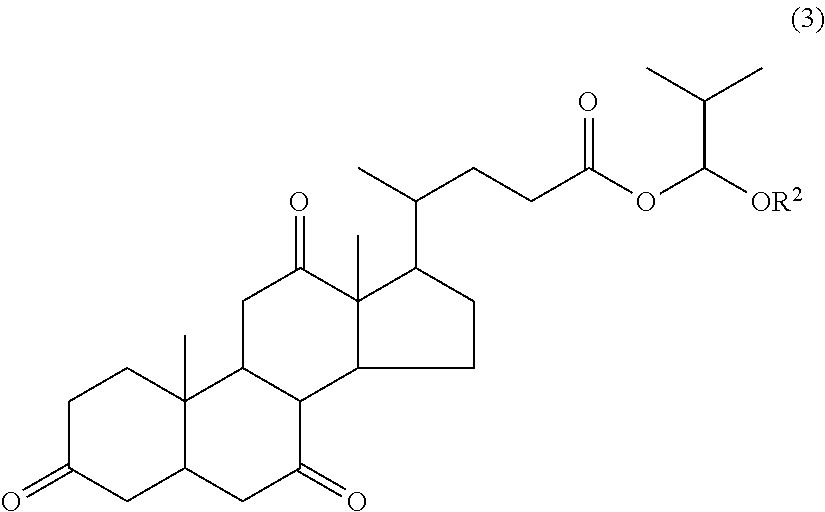Resist pattern forming process
- Summary
- Abstract
- Description
- Claims
- Application Information
AI Technical Summary
Benefits of technology
Problems solved by technology
Method used
Image
Examples
reference example 1
Synthesis of 1-ethylcyclopentyloxycarbonylmethyl dehydrocholate (A-1)
[0178]
[0179]A mixture of 4.0 g of dehydrocholic acid (S-1), 2.9 g of 1-ethylcyclopentyl chloroacetate (S-2), 1.2 g of triethylamine, 0.2 g of sodium iodide, and 24 g of dimethylformamide was stirred at 80° C. for 48 hours. The reaction mixture was diluted with methylene chloride, subjected to an ordinary aqueous workup, and purified by column chromatography, yielding 4.3 g of 1-ethylcyclopentyloxycarbonylmethyl dehydrocholate (A-1).
reference example 2
Synthesis of 1-ethylcyclopentyl dehydrocholate (A-2)
[0180]
[0181]A mixture of 4.2 g of dehydrocholic acid chloride (S-3), 1.7 g of 1-ethylcyclopentanol (S-4), 0.1 g of 4-dimethylaminopyridine, and 16 g of pyridine was stirred at 60° C. for 16 hours. The reaction mixture was diluted with methylene chloride, subjected to an ordinary aqueous workup, and purified by column chromatography, yielding 3.5 g of 1-ethylcyclopentyl dehydrocholate (A-2).
reference example 3
Synthesis of 1-methoxy-2-methylpropyl dehydrocholate (A-3)
[0182]
[0183]At room temperature, 6.1 g of 1-chloro-2-methylpropyl methyl ether (S-5) was added dropwise to a mixture of 20.0 g of dehydrocholic acid (S-1), 6.0 g of triethylamine, and 100 g of tetrahydrofuran, followed by stirring for 1 hour. The reaction mixture was diluted with toluene. After an ordinary aqueous workup, the solvent was distilled off in vacuum. The resulting solid was washed with isopropyl ether and dried in vacuum, yielding 21.9 g of 1-methoxy-2-methylpropyl dehydrocholate (A-3).
[0184]The target compound was analyzed by infrared (IR) absorption spectroscopy and nuclear magnetic resonance spectroscopy (1H-NMR), with the results shown below. Note that the compound is a mixture of two diastereomers in a ratio of 1:1.
[0185]IR (D-ATR): ν=2964, 2931, 2872, 1740, 1720, 1705, 1470, 1426, 1384, 1314, 1299, 1277, 1250, 1220, 1170, 1138, 1120, 1097, 972, 946, 911 cm−1
[0186]1H-NMR (600 MHz, THF-d8): δ=0.86 (3H, d, J=6...
PUM
 Login to View More
Login to View More Abstract
Description
Claims
Application Information
 Login to View More
Login to View More - R&D Engineer
- R&D Manager
- IP Professional
- Industry Leading Data Capabilities
- Powerful AI technology
- Patent DNA Extraction
Browse by: Latest US Patents, China's latest patents, Technical Efficacy Thesaurus, Application Domain, Technology Topic, Popular Technical Reports.
© 2024 PatSnap. All rights reserved.Legal|Privacy policy|Modern Slavery Act Transparency Statement|Sitemap|About US| Contact US: help@patsnap.com










